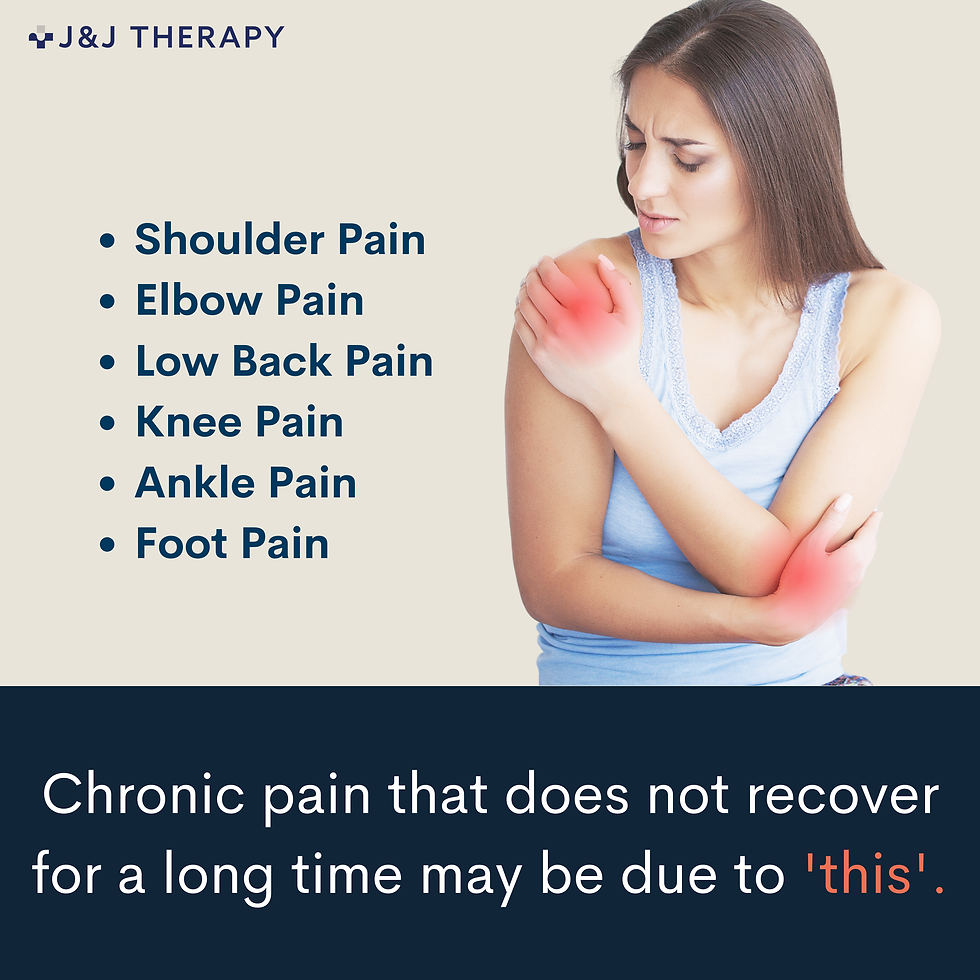Chronic Pain That Won’t Settle? The Real Reason & How We Fix It at J&J Therapy
- 지수 이
- Aug 11
- 2 min read









Chronic pain at a glance
Common areas: shoulder, elbow, low back, knee, ankle, foot.
Do these apply to you?
✓ | Checkpoint |
✓ | Pain has persisted 1–3 months or longer |
✓ | Pain keeps returning in the same spot |
✓ | Each flare‑up recovers more slowly than before |
What counts as chronic pain?
Most injury pain settles within about a month. When pain persists for 1–3 months or beyond, it’s reasonable to view it as chronic—often because the underlying cause is unresolved or the healing process is delayed (e.g., repeated friction in a narrowed shoulder joint space, or slow‑to‑heal tendons with limited blood supply).
Why healing stalls (simple science)
Mechanism | What happens | Typical example |
Mechanical impingement | Tight/altered posture narrows joint space → tissues rub and inflame again | Shoulder impingement |
Low‑blood‑supply tissues | Tendons/ligaments have few vessels → slow repair → repeat pain | Tennis/Golfer’s elbow, Achilles tendinopathy |
Load mismatch | Too much/too little/misaligned loading prevents adaptation | Return to sport or long desk work without prep |
Protective guarding | Pain → stiffness/weakness → more stress on sore area | “Frozen” patterns, fear of movement |
What actually helps (our clinic formula)
Method | What it aims to do | When we use it |
Shockwave therapy | Settles stubborn pain, stimulates local healing response and tissue release | Long‑standing tendon or myofascial pain |
Therapeutic/Corrective massage | Reduces tone, improves glide, opens space in tight areas | Impingement‑type pain, protective guarding |
Physiotherapy & exercise | Restore mobility, strength, and load tolerance; fix movement habits | All chronic pain cases |
Electro‑therapy (e.g., TENS/ultrasound) | Calm acute flares so you can move and exercise | When pain blocks movement |
Lymphatic massage | Ease swelling/heaviness to support recovery | Swollen or “heavy” limbs |
Our approach treats both the symptom (pain) and the cause (mechanics, load, tissue health) so relief lasts.
Your visit to J&J Therapy
Step | What we do |
1) Consultation | History, posture/joint space, tendon loading, daily habits |
2) Relief session | Shockwave + corrective massage targeting the driver |
3) Exercise & guidance | Simple drills, pacing plan, do’s & don’ts |
4) Follow‑up | Review progress; progress loading and home plan |
Opening hours: Tue–Wed & Fri–Sat 9:00–19:20 (Mon/Thu closed)WhatsApp: 07882 943540 (AI‑assisted, real‑time) • Text only: 07935 869938Email: info@jjwellcare.com
If you notice significant swelling, night pain, numbness/tingling, or sudden severe pain, please seek assessment promptly.
FAQs
Q1. Do I need a scan?Usually not. We consider imaging only if red flags or slow progress suggest it.
Q2. How soon might I feel better?Many feel lighter after the first session, particularly with shockwave + massage. Timelines vary with severity and goals.
Q3. Will it keep coming back?Not if we tackle the cause—joint space, tendon load, strength and habits—along with symptom relief.



Comments